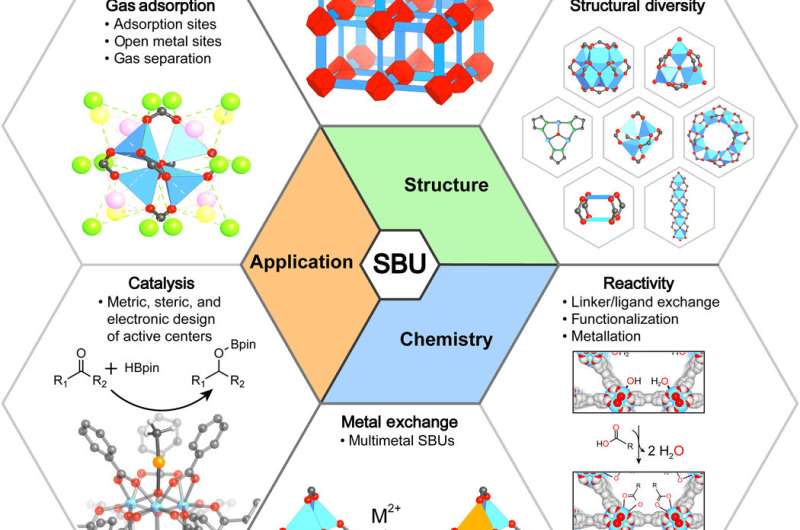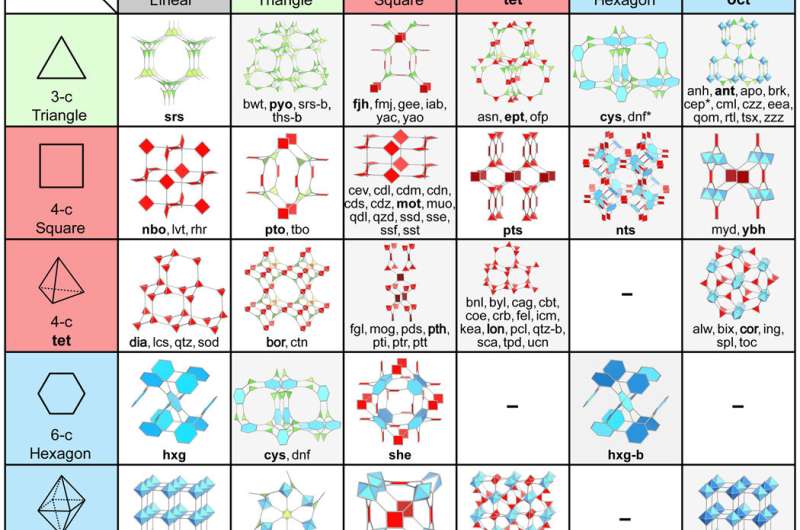October 22, 2018 feature
Secondary building units (SBUs)—the turning point in the development of metal-organic frameworks (MOFs)

There is an urgent need to control materials on the molecular level to make "materials on demand." A strategy to develop such materials is in development in reticular chemistry, derived from the Latin translation "reticulum" as "having the form of a net." The strategy links discrete building units (molecules and clusters) via bonds to make large and extended crystalline structures. Metal-organic frameworks (MOFs) are the most prominent class of materials in the realm of reticular chemistry. Such crystalline, extended structures are constructed by stitching together inorganic polynuclear clusters known as secondary building units (SBUs) and organic linkers via strong bonds.
The past two decades have witnessed an explosive growth in the field of MOFs, with more than 84,185 MOF structures documented in the Cambridge Crystallographic Data Centre. A collection of papers on the synthesis, structure and application of MOFs continues to be published every year. The SBU approach has advanced MOF chemistry as the most significant contributor to the rapid development observed in the field. Many MOF syntheses, investigations and applications are derived from the SBU approach. Now reviewing the field of MOF chemistry for Science Advances, Markus Kalmutzki, Nikita Hankel and Omar M. Yaghi – recently awarded the BBVA Foundation of Frontiers of Knowledge Award in the Basic Sciences category – consider the history of MOFs and their applications that have arisen via the SBU approach.
Metal-organic frameworks (MOFs) are a fascinating class of highly porous materials. They are structurally composed of metal ions/clusters and organic linkers for promising functional diversity in a variety of fields. Properties include their unique crystallinity, tunable porosity and structural diversity. The performance of MOFs was highlighted in diverse applications such as gas storage, catalysis sensing and drug delivery. In particular, SBUs play an important role in vapor absorption, as reported with high water absorption. The structural diversity of MOFs depends on SBUs with future work projected for industrial applications including gas absorption and separation, harvesting water from air, bioimaging and therapeutics.
By design, polynuclear cluster nodes, also known as SBUs, are able to impart (1) thermodynamic stability via strong covalent bonds and (2) mechanical/architectural stability by strong directional bonds that can lock down the position of metal centers in metal-organic frameworks. This property contrasts with those of unsteady and nondirectional single metal nodes that formed weak bonds to neutral organic donor linkers.

In contrast to the unpredictable method of traditional synthetic organic chemistry where little to no correlation exists between the structure of starting materials and products, greater predictability exists in MOF chemistry, as they are designed with predetermined topologies. In the synthetic process, the chemical building units required to construct the selected net are determined. The structural diversity observed in MOF chemistry originates from a wide variety of available SBU geometries; specific structures can be designed by choosing appropriately shaped and sized building units.
The authors then detailed diverse methods of MOF synthesis, their complexity, chemical frameworks and applications that originated from secondary building units during MOF development. In practice, MOFs can be used for gas storage and separation with specific implications to separate carbon dioxide and other greenhouse gases for environmental sustainability. Metal organic frameworks can also form versatile heterogenous catalysts for efficient organic transformations, be used as luminescent sensors and in drug cargo delivery for cancer therapy.
Applications in diverse fields were enabled by the porosity inherent to MOFs, made possible by the SBU approach. The chemical nature inherent to MOFs and SBUs that led to the development of the properties of adsorption, separation and catalysis were then dissected further within the review. The accessibility of pore space within open framework structures enabled the applications observed for MOFs in different fields. The basis for MOFs is related to the ability to manipulate matter with a precision previously only known in well-established molecular chemistry.
The crystallinity and porosity of the framework was fully preserved during construction, leading to the development of "crystals as molecules." Introduction of the SBU approach was a turning point that enabled the extension of precision chemistry from molecular complexes and polymers into 2-D and 3-D frameworks, to design rational structures using functional building units. Recent advances in the field of MOF synthesis confirm the potential to translate properties of functional building units into a structural framework. Such properties include linear and nonlinear optical character, magnetism, conductivity and catalysis. Recent advances in computational chemistry can also help understand material properties and predict structures that can be constructed with the targeted character.
Complexity and heterogeneity can be integrated within MOFs as recently proposed, to explore and analyze their impact on the structure and in the resulting properties, in the future. Both complexity and heterogeneity allow to further expand the scope of structures, providing access to materials with great potential for increased performance. Controlling the spatial distribution of different organic functionalities and metal ions can lead to design sequences within or along the MOF backbone. Expected spatial arrangements can be achieved by integrating multiple SBUs with specific binding patterns directly into framework formation for a single material, or via post-synthetic methods. The realization of this vision can give rise to sequence-specific materials designed into MOFs to carry out intended functions. Introduction of the SBU marks a turning point in the development of MOF chemistry – and will continue to play a key role in their future development to access novel structures, properties and applications.
More information: Markus J. Kalmutzki et al. Secondary building units as the turning point in the development of the reticular chemistry of MOFs, Science Advances (2018). DOI: 10.1126/sciadv.aat9180
Journal information: Science Advances
© 2018 Phys.org




















